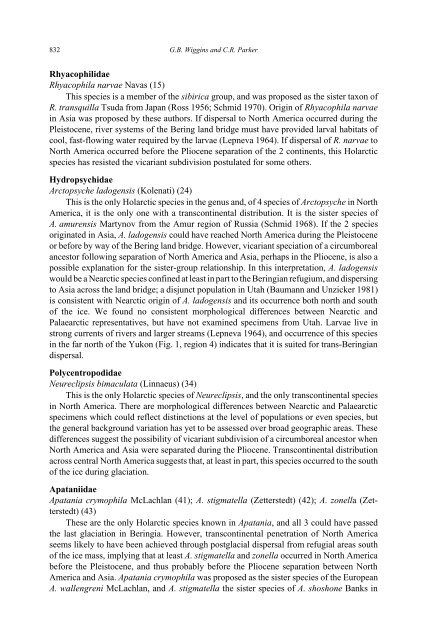Caddisflies of the Yukon - Department of Biological Sciences ...
Caddisflies of the Yukon - Department of Biological Sciences ...
Caddisflies of the Yukon - Department of Biological Sciences ...
Create successful ePaper yourself
Turn your PDF publications into a flip-book with our unique Google optimized e-Paper software.
832 G.B. Wiggins and C.R. Parker<br />
Rhyacophilidae<br />
Rhyacophila narvae Navas (15)<br />
This species is a member <strong>of</strong> <strong>the</strong> sibirica group, and was proposed as <strong>the</strong> sister taxon <strong>of</strong><br />
R. transquilla Tsuda from Japan (Ross 1956; Schmid 1970). Origin <strong>of</strong> Rhyacophila narvae<br />
in Asia was proposed by <strong>the</strong>se authors. If dispersal to North America occurred during <strong>the</strong><br />
Pleistocene, river systems <strong>of</strong> <strong>the</strong> Bering land bridge must have provided larval habitats <strong>of</strong><br />
cool, fast-flowing water required by <strong>the</strong> larvae (Lepneva 1964). If dispersal <strong>of</strong> R. narvae to<br />
North America occurred before <strong>the</strong> Pliocene separation <strong>of</strong> <strong>the</strong> 2 continents, this Holarctic<br />
species has resisted <strong>the</strong> vicariant subdivision postulated for some o<strong>the</strong>rs.<br />
Hydropsychidae<br />
Arctopsyche ladogensis (Kolenati) (24)<br />
This is <strong>the</strong> only Holarctic species in <strong>the</strong> genus and, <strong>of</strong> 4 species <strong>of</strong> Arctopsyche in North<br />
America, it is <strong>the</strong> only one with a transcontinental distribution. It is <strong>the</strong> sister species <strong>of</strong><br />
A. amurensis Martynov from <strong>the</strong> Amur region <strong>of</strong> Russia (Schmid 1968). If <strong>the</strong> 2 species<br />
originated in Asia, A. ladogensis could have reached North America during <strong>the</strong> Pleistocene<br />
or before by way <strong>of</strong> <strong>the</strong> Bering land bridge. However, vicariant speciation <strong>of</strong> a circumboreal<br />
ancestor following separation <strong>of</strong> North America and Asia, perhaps in <strong>the</strong> Pliocene, is also a<br />
possible explanation for <strong>the</strong> sister-group relationship. In this interpretation, A. ladogensis<br />
would be a Nearctic species confined at least in part to <strong>the</strong> Beringian refugium, and dispersing<br />
to Asia across <strong>the</strong> land bridge; a disjunct population in Utah (Baumann and Unzicker 1981)<br />
is consistent with Nearctic origin <strong>of</strong> A. ladogensis and its occurrence both north and south<br />
<strong>of</strong> <strong>the</strong> ice. We found no consistent morphological differences between Nearctic and<br />
Palaearctic representatives, but have not examined specimens from Utah. Larvae live in<br />
strong currents <strong>of</strong> rivers and larger streams (Lepneva 1964), and occurrence <strong>of</strong> this species<br />
in <strong>the</strong> far north <strong>of</strong> <strong>the</strong> <strong>Yukon</strong> (Fig. 1, region 4) indicates that it is suited for trans-Beringian<br />
dispersal.<br />
Polycentropodidae<br />
Neureclipsis bimaculata (Linnaeus) (34)<br />
This is <strong>the</strong> only Holarctic species <strong>of</strong> Neureclipsis, and <strong>the</strong> only transcontinental species<br />
in North America. There are morphological differences between Nearctic and Palaearctic<br />
specimens which could reflect distinctions at <strong>the</strong> level <strong>of</strong> populations or even species, but<br />
<strong>the</strong> general background variation has yet to be assessed over broad geographic areas. These<br />
differences suggest <strong>the</strong> possibility <strong>of</strong> vicariant subdivision <strong>of</strong> a circumboreal ancestor when<br />
North America and Asia were separated during <strong>the</strong> Pliocene. Transcontinental distribution<br />
across central North America suggests that, at least in part, this species occurred to <strong>the</strong> south<br />
<strong>of</strong> <strong>the</strong> ice during glaciation.<br />
Apataniidae<br />
Apatania crymophila McLachlan (41); A. stigmatella (Zetterstedt) (42); A. zonella (Zetterstedt)<br />
(43)<br />
These are <strong>the</strong> only Holarctic species known in Apatania, and all 3 could have passed<br />
<strong>the</strong> last glaciation in Beringia. However, transcontinental penetration <strong>of</strong> North America<br />
seems likely to have been achieved through postglacial dispersal from refugial areas south<br />
<strong>of</strong> <strong>the</strong> ice mass, implying that at least A. stigmatella and zonella occurred in North America<br />
before <strong>the</strong> Pleistocene, and thus probably before <strong>the</strong> Pliocene separation between North<br />
America and Asia. Apatania crymophila was proposed as <strong>the</strong> sister species <strong>of</strong> <strong>the</strong> European<br />
A. wallengreni McLachlan, and A. stigmatella <strong>the</strong> sister species <strong>of</strong> A. shoshone Banks in
















